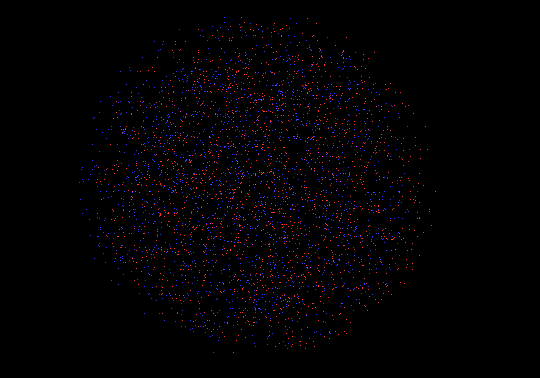
A primordial star condensing from gas (in 3D-stereo)

Fusion can progress no further than iron because this element has the highest binding energy and will thus release no more energy when fused, but rather consume energy to fuse it, thus reducing the temperature of the star. Synthesis of elements heavier than iron had to wait until the supermassive stars turned supernova, the central region having consumed all its nuclear fuel and being no longer able to support the stars' interior against gravitational collapse into a neutron star. This event was akin to the simultaneous beta decay of all the 1057 protons in the supernova when they suddenly transformed into neutrons and released 1057 neutrinos within 10 seconds. This vast flux of neutrinos irradiating the outer layers of the supermassive star with ultra-high energy particles to such an extent that they were blasted away from the neutron star out into interstellar space and at the same time transmuted into heavier elements by r-process neutron capture events resulting in elements ranging from iron to plutonium, and perhaps up to the still undiscovered element 118 and beyond. From such dust, Earth was eventually created.
The gravitational wave signal had a duration of about 100 seconds as the neutron stars danced around each other, losing orbital energy to enormously powerful radiating gravitational waves and getting ever closer together. The final more energetic fiery frenzied inward spiral took only 270 milliseconds to form a Black Hole which was 53 times the mass of the Sun, having radiated about 2.8 solar masses as gravitational waves as they danced together, a colossal energy flux which is 50 times greater than the power output of all of the stars in the Universe together! But observed from 1.8 Giga light-years away the received energy was extremely feeble. The Black Hole which resulted was spinning at 70% of the maximum it could possibly spin.
It should be noted that not all neutron star mergers will produce a black hole - much lighter neutron stars just result in a heavier neutron star (plus radiated gravitational waves, gamma rays and the production of heavy elements). In this instance, it is postulated that the merger of these two neutron stars at first briefly produced a larger neutron star before that collapsed milliseconds later into a Black Hole.
The gravitational waves were observed to travel at the speed of light to an accuracy of about 1 part in 3 × 1015, a measurement which further pins down any suggested deviation of the speed of gravitational waves from that of light; a deviation being a pre-requisite for any theory of Modified Gravity, which seems to put the kybosh on some of those theories. It also increased the measurement of Equivalence Principle, Einsteins postulated equivalence of inertial mass (experienced during acceleration) to gravitational mass - which is now measured to an accuracy of just 1 part in 1010. This single event increased the accuracy of these two comparison by many orders of magnitude at a stroke! These measurements now eliminate several other proposed alternative models to General Relativity.
The merger of these two neutron stars also produced an energetic gamma-ray burst (called GRBs) lasting 2 seconds, which confirms that these short but extremely energetic gamma ray bursts which astronomers have been detecting in recent years do actually emerge from neutron star mergers, and not from other suggested sources. It began 1.7 seconds after the neutron star merger. This GRB is labelled GRB170817A for a reason not known to your Author.
The gamma ray burst is followed by a longer after-glow which is powered by the radioactive decay of heavy elements (nuclei) known as a kilonova. Kilonova are strong candidates for the production of heavy elements in the Universe, those of atomic weight above that of iron, indeed, it is thought kilonova may produce half those heavy elements present in the Universe. It is estimated that this particular neutron star merger into a black hole produced heavy elements heavier than iron by r-process neutron-capture events amounting to 16,000 times the mass of the Earth!
During the fiery merger of these two neutron stars a huge quantity of heavy elements was created and left behind. This, more than supernova explosions, is now believed to be the major source of heavy elements in the Universe. At the time of the detection of the neutron star merger Cobalt, Gold and Silver were reported to have been produced in the news that followed, but in all likelihood, a great plethora of other heavier than iron elements were also produced which radio-announcers have never heard of!
![]()